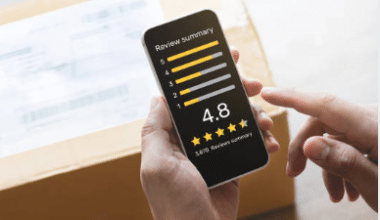As a business content writer, I’ve frequently found myself immersed in the complex world of competition analysis research. This is because a well-researched and informative competition analysis report is essential for revealing deep insights into your competitors’ operations, allowing you to strategize more effectively.
Also, businesses risk falling behind if they do not conduct thorough research and analysis. In this article, I will break down the procedures I use to build a competition analysis report and share thoughts along the way.
Key Takeaways
- A well-researched competitive analysis report is crucial for understanding competitors’ strategies, strengths, and weaknesses. It provides valuable insights that help businesses strategize effectively and avoid falling behind in a competitive market.
- Key pitfalls to avoid include data overload, which can overwhelm and dilute key insights; inaccuracies in data collection, which can mislead decision-making; and biases, which can skew the analysis.
- Tools like Sprout Social, Kompyte, Crayon, Brand24, and Ahrefs are vital for gathering and analyzing competitive data. They provide features such as social performance monitoring, AI-driven insights, and comprehensive SEO analytics, helping streamline the process and enhance the quality of the analysis.
- The design of the report significantly impacts its effectiveness. Starting with a template, maintaining consistent design elements, and using visuals to summarize data are crucial for creating a clear, engaging, and actionable report. This helps in communicating complex information more effectively and keeping stakeholders engaged.
What is Competitive Analysis?
Competitive analysis is an essential component of a company’s marketing and business strategies. It entails discovering and assessing your competitors’ strategies to establish their strengths and weaknesses in comparison to your product or services.
This report assists you in developing tactics that will give you a distinct edge, developing barriers to prevent competition from entering your market and identifying any flaws that can be exploited during the product development cycle.
What is a Competitive Analysis Report?

A competitive analysis report is a strategic document that looks at your competitors’ position and performance in your industry. The report summarizes your competitive intelligence study data and offers recommendations for enhanced decision-making. It aids in understanding the competitive landscape, identifying areas for innovation or development, and developing strategies to outperform competitors.
Think of it as a strategic map that shows you where you stand in the market and where you need to turn. When I initially began writing for businesses, I remember how difficult it was to grasp why a specific tactic worked or failed. It was a competitive analysis report that gave clarity and guidance. A competitive analysis report will often include the following:
- A description of your business’s target market
- Details about the features of your product compared to your competitors’ products
- A breakdown of current and projected market share, sales, and revenues
- Comparisons of pricing models
- An analysis of marketing strategy and social media strategy
- A description of customer ratings of the features of each competitor
Whether you’re a startup trying to break into the marketplace, a consultant trying to get results for your client, or an established company looking to cement your foothold against the competition, a well-researched competitive analysis gives you the tools you need to make strategic decisions. Your competitive analysis should inform your marketing plan, your business plan, your consultant report, and every part of your high-level business strategy.
Top Competitive Analysis Reporting Tools
Competitive monitoring tools help optimize the research process, analyze multiple data points, and deliver data-driven insights you can use immediately. Check out these tools that help streamline the process of creating competitive analysis reports.
#1. Sprout Social
Sprout Social provides powerful tools to help you monitor your competitors’ performance across social platforms like Instagram, Facebook, and X (formerly Twitter).
It allows you to compare your social performance to that of your top competitors to really grasp your brand’s social health. Sprout’s Advanced Listening tool allows you to listen in on conversations about yourself, your industry, and competitors across social media channels, review sites, and communities.
With its strong AI technology, you can quickly sift through millions of discussions to find insights about relevant issues, your audience, and your industry. These insights enable you to assess your share of voice (SOV), devise crisis management tactics, and find new market opportunities.
With tools like Premium Analytics and Sprout’s collection of competitive reports, you can simply see and demonstrate the impact of an extensive competition analysis study. Your report may include:
- Customized metrics based on your business goals and team’s priorities
- Interactive charts and graphs that illuminate critical social data
- Custom date range comparisons for performance benchmarking.
With Sprout’s dynamic shareable link, you can quickly share the report with your team and external shareholders outside Sprout.
#2. Kompyte
Kompyte gathers competitive intelligence from millions of data points, including social, website, content, ads, reviews, job postings, and more. The platform uses artificial intelligence to filter through the noise and deliver actionable insights on your competitors.
It automatically organizes competitive data into battle cards, highlighting differentiators, market feedback, revenue, and everything else your sales teams need to win deals.
#3. Crayon
Crayon uses artificial intelligence to track your competitors and also gives you alerts based on your requirements. It analyzes social content, reviews, press releases, pricing updates, and other information to collect and provide insights into top competitors to keep your teams informed with relevant data.
Crayon allows you to create customizable reports and use battle cards, newsletters, and announcements to share competitive intelligence data with your team.
#4. Brand24
Brand24 is a media monitoring tool that’ll help you file competitive analysis reports. You can monitor competitors’ brand mentions across the web and measure their impact on brand awareness.
Not only will you have an overview of your competitors’ market share, but you’ll also get in-depth PDF reports directly in your inbox. We’re also introducing AI reports that analyze brand mentions and provide insights based on the results.
AI reports & insights use artificial intelligence to summarize your brand’s performance
The comparison tab is especially useful for creating competitive analysis reports.
Brand24’s Comparison tab allows you to perform a competitive analysis
Media monitoring is a crucial part of competitive analysis, so don’t sleep on this part!
#5. Ahrefs
Ahrefs is a direct competitor to Semrush. It’s another all-in-one SEO suite that combines keyword research and other useful SEO statistics with website analytics. Using Ahrefs, you can identify competitors, check their website estimate traffic, and compare keyword databases.
Ahrefs is useful not only for competitive analysis but also can give you a good overview of your site’s health and pinpoint things to improve.
How to Conduct Competitor Analysis Report: Before You Begin
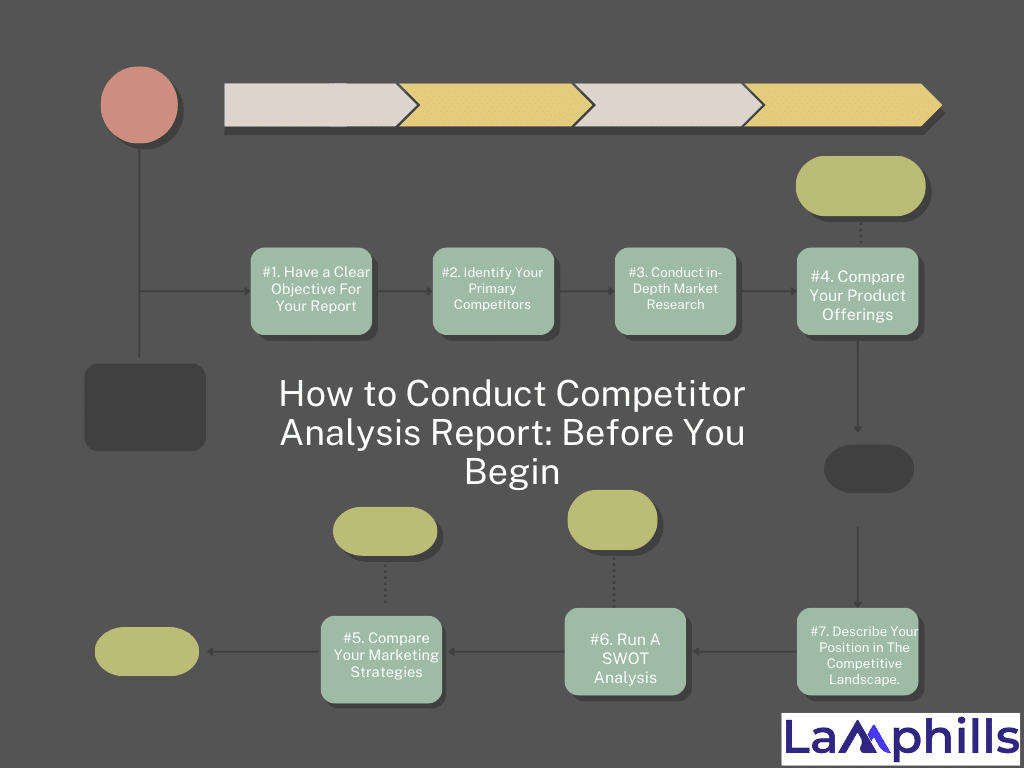
Performing a competitor analysis involves several steps that help you identify who your competitors are, what they’re doing, and how you can differentiate your own business. Here’s a simple step-by-step guide to performing a competitive analysis:
#1. Have a Clear Objective For Your Report
Because competition analysis impacts every part of your organization, it can rapidly become overwhelming. Outline it at the start of your document to make your goals and objectives clear. This will prevent you and your report from becoming lost in the massive amount of data you will unearth.
Do you wish to research all aspects of your competition and provide a comprehensive report? Or are you more interested in certain topics, such as their sales and marketing strategies? Your goal will influence your research and determine the format of the report.
#2. Identify Your Primary Competitors
Once you’ve determined the “why,” identify the competitors you must exceed to achieve a market advantage. You can discover these competitors by conversing with your sales team about customer feedback. Alternatively, you can use competitive monitoring and social listening to learn what other companies your audience is interested in.
It’s also important to identify your SEO competitors, as they can sometimes differ from your business competitors. You can find SEO competitors by using keyword research tools to check who’s ranking for your target keywords.
#3. Conduct In-Depth Market Research
The second phase is market research, which involves gathering and organizing information about your rivals, customers, and industry. Deep dive into certain client segments with detailed customer profiles that can help you make marketing decisions later on. A social analytics solution like Sprout Social allows you to do market research on social channels by utilizing powerful social media listening.
Create advanced listening searches to follow millions of conversions occurring around key themes and obtain a complete scope of your data for analysis insights by tweaking key filters without changing queries. Keep track of your competitors’ social strategies, discover what works in your industry, and assess how successfully client needs are addressed.
#4. Compare Your Product Offerings
Compare your product to competitors in terms of quality, pricing, customer service, and other factors to identify your differentiators. Use social listening to acquire information, and search forums such as G2, Capterra, and TrustPilot for neutral opinions on your product and competitors. It is not necessary to compare every feature you and your competitors provide. Instead, concentrate exclusively on those that are relevant to the goals of your investigation.
#5. Compare Your Marketing Strategies
To understand how each rival does business, look at their marketing and sales techniques. The idea is to study the elements that contributed to their success and apply those insights to inform your plan. Examine factors like their content marketing strategy, influencer partnerships, and sales channels.
Check out the channels they utilize to communicate and engage with customers, promote their business, and drive the most visibility. The report should show how each competitor tells their brand story and the value it delivers to customers. These insights will help with clarifying your position and messaging to differentiate your brand and stand out among competitors.
#6. Run A SWOT Analysis
A SWOT analysis evaluates your company’s competitive position by outlining its strengths, weaknesses, opportunities, and threats based on all available data. For example, competitor analysis can assist you in gathering key information through strategic social listening using filters such as keywords, content type, social networks, common themes in listening data, and so on, allowing you to synthesize key areas of focus for the business across the competitive landscape. It’s also a terrific method to present all of your findings in an understandable and shareable fashion.
#7. Describe Your Position in The Competitive Landscape.
Finally, a competitive analysis report must demonstrate where your company and all major competitors stand in the competitive landscape. This can be accomplished by identifying the two most important dimensions for competitiveness in your market and mapping them on a matrix alongside your company and its competitors.
With that, you’ll get a clear idea of your position based on the SWOT analysis you created earlier. Then conclude the report by making recommendations that serve the original purpose of the competitive analysis.
How to Create a Competitor Analysis Report: After You Have Conducted
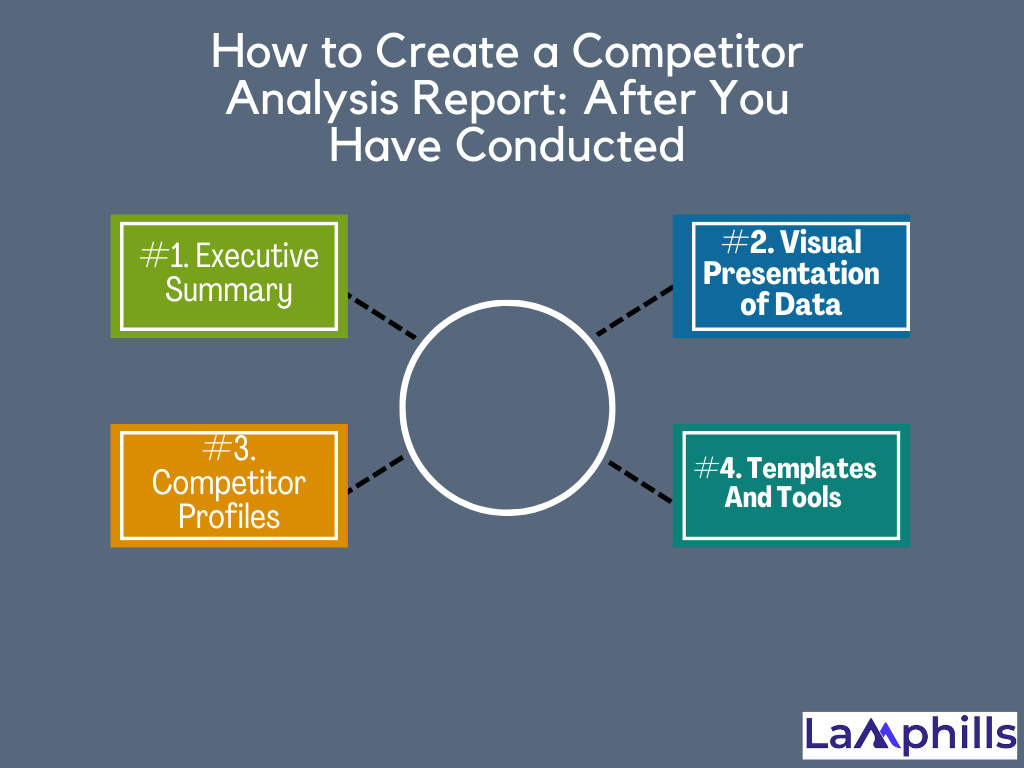
Once you’ve gathered your data, it’s time to translate it into an informative and actionable report. To maximize its impact, try including these key elements, which can be the framework of a competitive analysis template:
#1. Executive Summary
Begin with an executive summary that highlights the important findings of your investigation. This part should provide a high-level overview of the most important insights, allowing stakeholders to easily understand the key points. Highlight major competitive advantages or threats, then summarize your strategic recommendations.
#2. Visual Presentation of Data
Use charts, graphs, and comparison tables to visually present your data. This makes the information more accessible and understandable, allowing for rapid analysis and decision-making. Visual aids are especially useful for showing patterns, comparisons, and crucial metrics that may be overlooked in prose descriptions.
#3. Competitor Profiles
Provide a thorough competitive study for each important rival. Competitive analysis profiles should highlight the competitors’ strengths, weaknesses, market positioning, and any other pertinent results from your analysis Keeping these profiles concise and informative helps stakeholders quickly understand each competitor’s landscape.
#4. Templates And Tools
To streamline the creation of your report, utilize templates and professional tools. These resources can help ensure consistency in your report’s structure and design, making it easier to produce and update. Templates can also help ensure that no critical information is overlooked and that the report maintains a professional appearance.
Common Pitfalls to Avoid in the Competitive Analysis Report
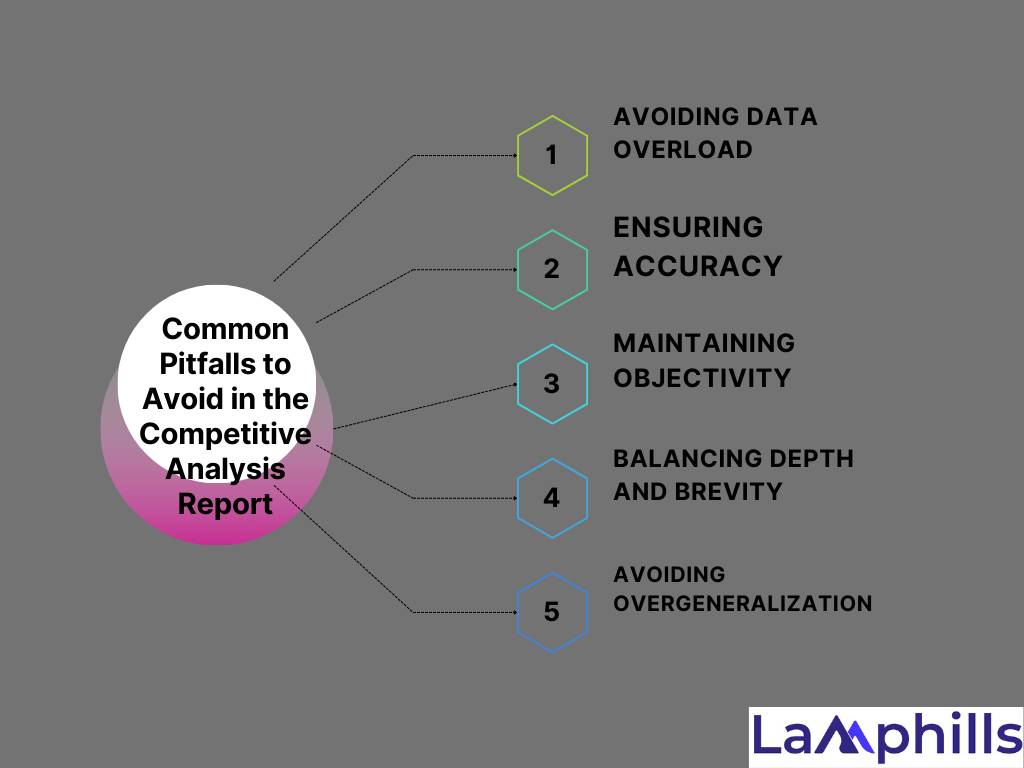
Creating a comprehensive competitive analysis report can be a complex task. Over the years, I’ve encountered a few common pitfalls that can derail even the best efforts. Here’s a closer look at these pitfalls, along with practical tips to help you steer clear of them.
#1. Avoiding Data Overload
When working on a competition analysis report, dealing with data overload might be difficult. With so much information at our disposal, it’s easy to become disoriented. I remember a project I worked on for a marketing agency that required us to analyze data from different sources. Initially, the report was densely packed with numbers, making it impossible to extract useful insights.
To avoid data overload, begin by outlining specific goals for your report. What are you hoping to achieve? For example, if your goal is to understand competitors’ pricing tactics, concentrate on pricing data and market trends.
Here’s a practical tip: use a data prioritization matrix. This tool helps you rank data based on its relevance and impact. During a competitive analysis project for a retail client, we used this matrix to prioritize data that directly affected their market position. By focusing on high-impact data, we were able to craft a more actionable report.
#2. Ensuring Accuracy
Accuracy is the backbone of a credible competitive analysis report. I’ve had my share of experiences where inaccuracies in data led to misguided recommendations. One memorable instance involved a client who relied on outdated market data, which skewed their understanding of their competitors’ market share. Here are some common errors to watch out for:
- Incorrect Data Sources: Using unreliable or outdated sources can compromise accuracy. Always cross-check data from multiple reliable sources.
- Data Entry Mistakes: Simple errors in data entry can lead to significant inaccuracies. Double-check your numbers and calculations.
To ensure accuracy, implement a data validation process. This involves cross-referencing data points and having a second set of eyes review the information. For example, in a project analyzing competitor financials, we validated our data by comparing it with industry reports and conducting a peer review. This step helped us catch discrepancies early and ensured the final report was accurate.
#3. Maintaining Objectivity
Objectivity is crucial when analyzing and reporting data. It’s easy to let personal opinions or biases creep in, which can skew your findings. I recall working on a competitive analysis for a tech startup where I had a strong preference for a particular technology. This bias almost influenced the report’s recommendations.
To maintain objectivity:
- Stick to the Data: Base your analysis solely on data and facts, not personal opinions.
- Seek Multiple Perspectives: Collaborate with team members or stakeholders who can provide different viewpoints. This helps in balancing the analysis and reducing individual biases.
In my experience, having a review process where others can critique the report before it’s finalized has been invaluable. For instance, during a project for a consumer goods company, we had multiple team members review the findings. Their feedback helped us refine our analysis and eliminate any potential biases.
#4. Balancing Depth and Brevity
While it’s important to be thorough, excessive detail can overwhelm the reader. I’ve faced challenges where a report was so detailed that it became difficult for decision-makers to extract key insights quickly. Balancing depth with brevity ensures that the report is both comprehensive and digestible.
How to Balance
- Summarize Key Points: Use executive summaries to highlight the most important findings.
- Use Clear Visuals: Charts and graphs can help distill complex information into understandable visuals.
For a competitive analysis report I worked on for a financial services firm, we included a concise executive summary at the beginning. This summary highlighted the critical insights and recommendations, allowing stakeholders to quickly grasp the key takeaways before diving into the detailed sections.
#5. Avoiding Overgeneralization
Overgeneralizing can lead to misleading conclusions. I once worked on a competitive analysis for a fashion retailer where the initial report generalized competitor strategies without accounting for market segments. This oversight led to recommendations that weren’t fully relevant to all target markets.
- Segment Your Analysis: Break down competitors and market data into relevant segments. This approach ensures that recommendations are tailored to specific market conditions and target audiences.
- Provide Specific Recommendations: Avoid vague suggestions. Ensure that recommendations are actionable and specific to the data analyzed.
During a project for an e-commerce company, we divided competitors into product categories and target demographics. This segmentation enabled us to provide focused recommendations that were specifically relevant to each segment, resulting in more effective strategic measures.
By avoiding these frequent problems and implementing these tactics, you can improve the quality and efficacy of your competition analysis reports. If you have any further queries or require additional assistance, please ask!
Tips to Improve Your Competitive Analysis Report Design
How you design your competitive analysis report can have a significant impact on your business success. The right report design can inspire stakeholders to take action based on your findings, while a mediocre design may reflect poorly on your hard work.
Here are a few report design best practices to keep in mind when designing your competitive analysis report:
- Start with a competitive analysis report template.
- Keep core design elements like colors and fonts consistent.
- Use visuals to summarize important information and keep your audience engaged
#1. Start with a Competitor Analysis Template
The easiest way to lose your stakeholders’ trust is to deliver a sloppy, unprofessional report design. In addition to diverting from the report’s content, it may jeopardize your credibility.
Starting with a pre-designed competitor analysis template, such as the one below, eliminates practically all of the design work, allowing you to focus on the content (while also impressing your stakeholders).
And if you’re a consultant competing for a project, a pre-designed template may just give you the edge you need to land that client.
Click on any of our templates; you’ll enter our online drag-and-drop report maker tool. No design knowledge is required.
#2. Keep Core Design Elements Like Colors and Fonts Consistent
If you take a look at the competitor analysis template below, you might notice that the designer has switched up the layout from page to page, but many of the other design elements are kept consistent.
That consistency helps the report design feel cohesive while making it easier for readers to quickly skim for key pieces of information.
Here are a few quick guidelines for keeping important design elements consistent:
- Use the same color scheme throughout your report (with one highlight color to draw attention to key takeaways and important numbers)
- Use the same font styles for your headers, subheaders, and body text (with no more than 2-3 font styles per report)
- Use the same style of visuals throughout your report (like flat icons or illustrated icons… but not both)
#3. Use Visuals to Summarize Important Information
The challenge with a competitive analysis report is that you collect heaps of background research, and you have to condense it into a brief report that your client will actually read.
And written summaries will only get you so far.
Visuals like charts and tables are a much better way to communicate a lot of research quickly and concisely, as seen in the market research summary below.
Even lists can be made more engaging and informative by spacing out list items and giving more emphasis to headers:
The more you can replace descriptive paragraphs and long lists with thoughtful visuals, the more your readers will thank you.
Benefits Of a Competitive Analysis Report
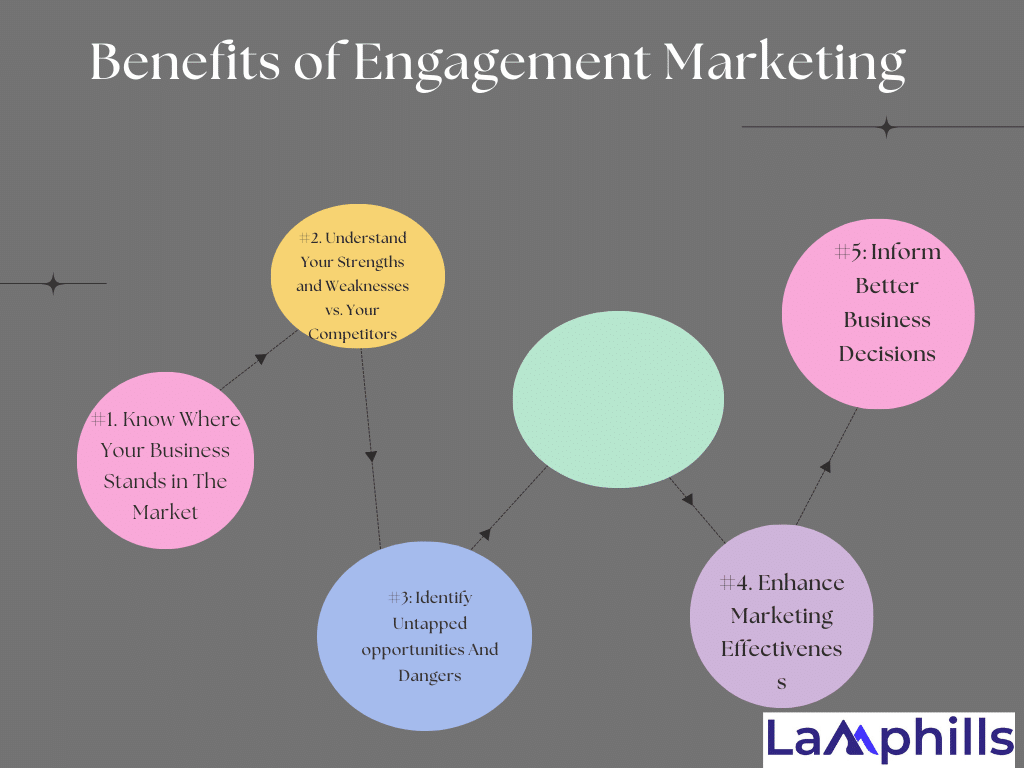
A competitive analysis report serves as a tool for competitor benchmarking. You can use it as a standard for realistic goal setting, accessing your business performance, and measuring growth. Let’s dive into some more key benefits.
#1. Know Where Your Business Stands in The Market
A good competitive analysis provides a realistic insight into your company’s position in the market. Instead of making assumptions, utilize your report to perform data-driven calculations to see how your company compares in terms of market share, customers, messaging, and distinction.
For example, assume you sell video editing software. In that instance, you might utilize a competitive analysis study to determine how easy or difficult it is for novices to use your product compared to your competitors’ tools. With this knowledge, you can develop your unique selling proposition, evaluate client preferences, discover gaps, and devise a positioning plan that connects your business objectives with customer demands.
#2. Understand Your Strengths and Weaknesses vs. Your Competitors
Digging into competition data reveals not only their strengths and faults but also your own. Competitive reporting, when done correctly, eliminates prejudice and provides raw facts on where your company thrives and where it falls short.
A competitive analysis report also highlights your competitors’ mistakes, failures, and accomplishments. As a result, you may capitalize on your triumphs, avoid repeating mistakes, and better position your growing business.
#3: Identify Untapped opportunities And Dangers
A detailed competitive assessment identifies growth prospects such as untapped markets, new client segments, and areas in which your competitors are underperforming. It also identifies possible dangers, such as new market entrants or changes in customer behavior. With this knowledge, you may devise tactics to close the gaps.
#4. Enhance Marketing Effectiveness
Reporting on your competitors’ marketing strategy provides an opportunity to assess and improve your own. For example, if you detect gaps in your competitor’s product, messaging, or positioning, you can develop ways to differentiate yourself by marketing and selling your distinct value more successfully.
#5: Inform Better Business Decisions
A competitive analysis report’s insights can help businesses make better decisions across departments like product, marketing, and procurement. By basing your plans on data-driven insights, you may better protect your market and meet client demands.
What Is a Competitive Analysis Framework?
A competitive analysis framework is a structured approach used to evaluate potential competitors and understand their strengths, weaknesses, opportunities, and threats.
What Are the 5 Parts of a Competitive Analysis?
The five key components of a competitive analysis include:
- Company overview. A brief snapshot of the competitor, including its history, size, and mission.
- Product/service analysis. An examination of their key products or services and how they compare to yours.
- Marketing strategy. Insights into their promotional tactics, target audience, and unique selling propositions.
- Operational analysis. An understanding of their supply chain, distribution, and customer service practices.
- Strengths and weaknesses. A clear breakdown of where the competitor excels and where they might be vulnerable.
What Are the 3 C’s in a Competitive Analysis?
The 3 C’s refer to a strategic model that considers three main factors when understanding the broader business environment:
- Company. Understanding your own strengths, weaknesses, opportunities, and threats.
- Customers. Knowing who your target audience is, what they value, and how they behave.
- Competitors. Analyzing direct and indirect competitors to determine market dynamics and potential threats.
Is SWOT Analysis a Competitive Analysis?
Yes, SWOT analysis is a type of competitive analysis. SWOT stands for Strengths, Weaknesses, Opportunities, and Threats. It is a strategic planning tool used to identify and analyze these four elements of a business.
Final Thoughts
A successful competitor analysis report is based on clarity, comprehensiveness, and strategic relevance. It paints a clear picture of the competitive landscape and provides decision-makers with actionable insights.
Also, a well-crafted report includes thorough data, smart analysis, and clear visuals such as charts and competitor profiles. Most significantly, it is consistent with the company’s primary objectives, providing a road map for navigating the market and establishing a competitive advantage.





